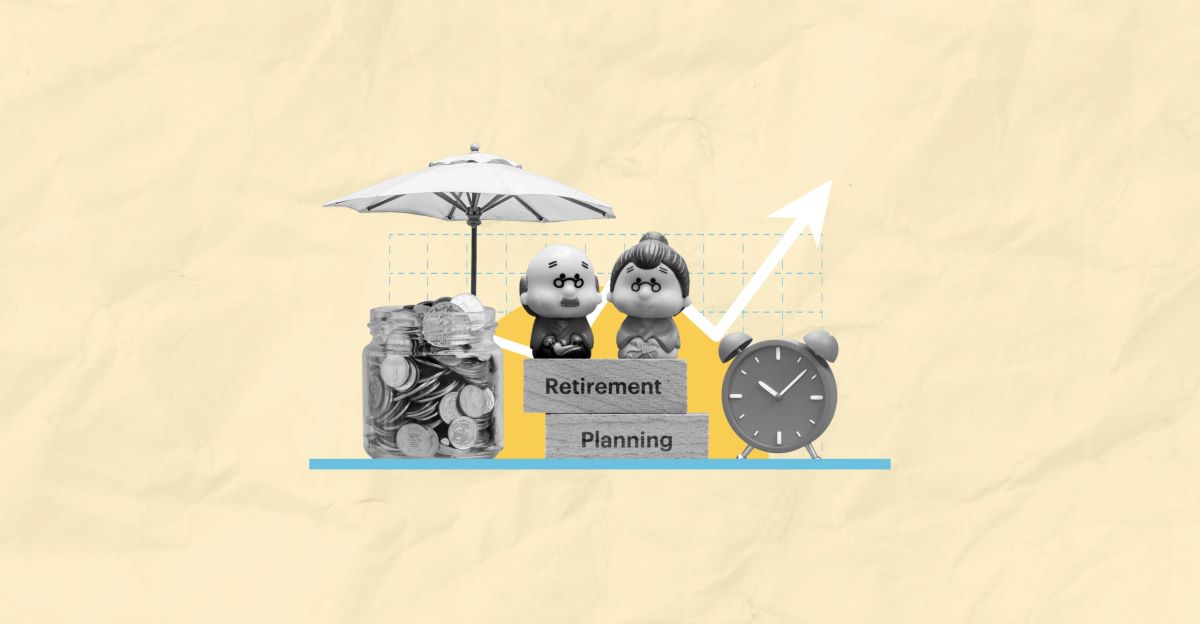Home>Finance>What Should I Consider For Life Expectancy In Retirement Planning


Finance
What Should I Consider For Life Expectancy In Retirement Planning
Published: January 21, 2024
Considering life expectancy is crucial in retirement planning. Find out what factors to consider for your financial future.
(Many of the links in this article redirect to a specific reviewed product. Your purchase of these products through affiliate links helps to generate commission for LiveWell, at no extra cost. Learn more)
Table of Contents
- Introduction
- Factors Affecting Life Expectancy
- Health and Lifestyle Choices
- Family History and Genetics
- Socioeconomic Factors
- Medical Advances and Technology
- Life Expectancy Calculators and Tools
- Importance of Accurate Life Expectancy Estimation in Retirement Planning
- Strategies for Retirement Planning Considering Life Expectancy
- Conclusion
Introduction
Retirement planning is a critical aspect of ensuring financial security and stability during the later years of life. However, one integral factor that often gets overlooked is life expectancy. Life expectancy refers to the average number of years a person is expected to live based on various factors such as health, genetics, and lifestyle choices. It is crucial to consider life expectancy when planning for retirement, as it directly impacts the amount of money needed to sustain a comfortable lifestyle.
With advances in healthcare and technology, people are living longer than ever before. This means that retirees may need to plan for a longer retirement period, requiring a greater financial cushion. On the other hand, unforeseen health issues or lifestyle choices can significantly impact life expectancy, altering retirement plans. To make informed decisions, individuals must carefully assess the factors that influence life expectancy.
In this article, we will delve into the factors affecting life expectancy and explain why accurately estimating life expectancy is essential for effective retirement planning. We will also discuss various strategies to consider when planning for retirement, taking life expectancy into account.
By gaining a comprehensive understanding of the factors influencing life expectancy and employing appropriate strategies, individuals can better prepare for a financially secure and comfortable retirement.
Factors Affecting Life Expectancy
Life expectancy is influenced by a range of factors that can vary from person to person. These factors can broadly be categorized into health and lifestyle choices, family history and genetics, socioeconomic factors, and medical advances and technology. Understanding these factors can provide valuable insights into estimating life expectancy.
Health and Lifestyle Choices: It comes as no surprise that health plays a crucial role in determining life expectancy. Leading a healthy lifestyle by exercising regularly, maintaining a balanced diet, avoiding smoking, and moderating alcohol consumption can significantly increase life expectancy. Chronic illnesses such as heart disease, diabetes, and cancer can reduce life expectancy, emphasizing the importance of managing and treating these conditions effectively.
Family History and Genetics: Another significant factor in determining life expectancy is family history and genetics. Certain genetic conditions and family predispositions can increase the likelihood of developing specific health issues that may impact longevity. By understanding one’s family history and genetic makeup, individuals can take proactive measures to mitigate potential genetic risks and make more informed decisions about their retirement planning.
Socioeconomic Factors: Socioeconomic factors such as education level, income, and access to healthcare services can also influence life expectancy. Higher education levels are associated with greater access to resources and better health outcomes, leading to an increased life expectancy. Similarly, individuals with higher incomes may have better access to quality healthcare, leading to earlier detection and treatment of health conditions, thus impacting life expectancy.
Medical Advances and Technology: Advances in medical technology and healthcare have significantly contributed to increased life expectancy. Improved treatments, early detection of diseases, and medical interventions have extended the average lifespan. Staying informed about medical advancements and utilizing appropriate preventive measures and treatments can positively impact one’s estimated life expectancy.
By considering these factors and how they apply to your personal circumstances, you can better estimate your life expectancy. This knowledge is crucial when planning for retirement, as it can inform decisions about financial savings, investments, and lifestyle choices.
Health and Lifestyle Choices
When it comes to life expectancy, our health and lifestyle choices play a significant role. Making conscious decisions to prioritize our well-being can have a profound impact on how long we live and the quality of our later years. Here, we will explore some key health and lifestyle choices that can influence life expectancy.
Regular Exercise: Engaging in regular physical activity is crucial for maintaining good health and increasing life expectancy. Regular exercise can help prevent chronic conditions such as cardiovascular disease, obesity, and diabetes. It also strengthens muscles, improves flexibility, and boosts overall mental well-being. Aim for at least 150 minutes of moderate-intensity aerobic activity or 75 minutes of vigorous-intensity aerobic activity each week.
Healthy Eating Habits: A balanced diet rich in fruits, vegetables, whole grains, lean proteins, and healthy fats is vital for maintaining optimal health. Adopting a diet that is low in processed foods, added sugars, and sodium can significantly reduce the risk of developing chronic diseases. It’s important to avoid excessive calorie intake and monitor portion sizes to maintain a healthy weight.
Avoiding Tobacco and Excessive Alcohol Consumption: Smoking and excessive alcohol consumption have detrimental effects on health and can significantly reduce life expectancy. Smoking is a leading cause of various types of cancer, heart disease, and respiratory problems. Similarly, excessive alcohol consumption can damage the liver, increase the risk of accidents, and negatively impact overall health. Quitting smoking and drinking alcohol in moderation can help improve overall well-being and increase life expectancy.
Stress Management: Chronic stress can have adverse effects on both physical and mental health. It is essential to find healthy coping mechanisms to manage stress effectively. Engaging in activities like meditation, yoga, or any form of relaxation can help reduce stress levels and promote a healthier lifestyle. Taking time for self-care and building a strong support system can also contribute to overall well-being.
Regular Health Check-ups: Regular health check-ups and screenings are critical for early detection and treatment of potential health issues. Routine screenings for conditions such as high blood pressure, cholesterol levels, diabetes, and various types of cancers can help identify problems in their early stages. Early intervention and treatment can significantly improve health outcomes and increase life expectancy.
By making conscious choices to prioritize our health and well-being, we can increase our chances of living longer, healthier lives. These choices not only impact life expectancy but also contribute to a better quality of life during the retirement years.
Family History and Genetics
Family history and genetics play a significant role in determining our life expectancy. The genetic traits and medical conditions that run in our families can provide valuable insights into our potential health risks and overall longevity. Understanding and considering this information is crucial when planning for retirement. Here, we will explore the impact of family history and genetics on life expectancy.
Genetic Predispositions: Our genetic makeup can influence our susceptibility to certain health conditions and diseases. For example, certain genetic mutations can increase the risk of developing conditions like hereditary cancers, cardiovascular diseases, or neurodegenerative disorders. Being aware of these genetic predispositions can help individuals take proactive measures to mitigate risks and make lifestyle choices that promote long-term health.
Family Health History: Examining the health history of our immediate family members can provide insights into potential health risks and conditions that may impact life expectancy. Conditions like diabetes, heart disease, and certain types of cancers may have a hereditary component. Knowing this information can prompt individuals to engage in preventive measures, such as regular health screenings, adopting healthy lifestyle choices, and seeking appropriate medical guidance.
Screening and Testing: Genetic testing and screening are becoming more accessible and can provide valuable information about an individual’s predisposition to certain health conditions. This information can be used to make informed decisions about lifestyle choices, medical interventions, and financial preparations for retirement. If there is a strong family history of a specific condition, consulting with a genetic counselor can provide further guidance and personalized recommendations.
Longevity of Family Members: Looking at the average lifespan of family members can give us a general idea of the potential lifespan within our genetic pool. If we come from a family with a history of longevity, it may suggest that we are genetically predisposed to live longer as well. However, it is essential to note that genetic factors are only one piece of the puzzle, and lifestyle choices and environmental factors also significantly influence life expectancy.
While family history and genetics provide important insights, it is crucial to remember that they are not absolute predictors of individual life expectancy. Lifestyle choices, environmental factors, and medical advancements all contribute to our overall health and longevity. By being aware of our family history and genetic predispositions, we can take proactive steps to lead healthier lives and make informed decisions about our retirement planning.
Socioeconomic Factors
Socioeconomic factors play a significant role in determining life expectancy. These factors encompass various aspects such as education level, income, occupation, access to healthcare, and quality of living conditions. Understanding how these factors influence life expectancy is crucial when considering retirement planning. Let’s explore the impact of socioeconomic factors on life expectancy.
Education Level: Higher education is often associated with better health outcomes and increased life expectancy. Individuals with higher education levels tend to have more knowledge about healthy behaviors, better access to job opportunities with higher incomes, and greater access to healthcare. This leads to a better quality of life and improved longevity.
Income and Occupational Factors: Income and occupation are intertwined with life expectancy. Higher income levels provide individuals with greater access to resources, including healthcare, better nutrition, and living conditions. Additionally, certain occupations, such as jobs with exposure to hazardous environments or high-stress levels, can impact health and longevity. Lower-income individuals may face challenges in accessing quality healthcare and may have limited resources to invest in healthy lifestyle choices.
Access to Healthcare: Access to affordable, quality healthcare is vital for maintaining good health and increasing life expectancy. Individuals with limited access to healthcare services may delay or forgo necessary medical treatment, resulting in poorer health outcomes and a shorter life expectancy. Addressing healthcare disparities and ensuring equitable access to healthcare can positively impact life expectancy.
Living Conditions: The living conditions in which individuals reside can also influence life expectancy. Factors such as access to clean water, sanitation, and green spaces are important contributors to health. Living in areas with higher levels of pollution, crime rates, or inadequate infrastructure can negatively impact health, resulting in shorter life expectancy.
Social Support and Community: Social support networks and community involvement can play a significant role in promoting health and increasing life expectancy. Strong social connections and a sense of belonging have been linked to improved mental health, lower stress levels, and better health outcomes. Engaging in community activities, having a support system, and fostering meaningful relationships can contribute to a longer and healthier life.
It is important to recognize the influence of socioeconomic factors on life expectancy when planning for retirement. By understanding the impact of these factors, individuals can take actionable steps to improve their socioeconomic circumstances, access appropriate healthcare, and make informed decisions that promote a longer and healthier retirement.
Medical Advances and Technology
The field of medicine has witnessed remarkable advancements and technological innovations over the years, leading to increased life expectancy. These medical advances and technologies have played a pivotal role in improving healthcare outcomes and enhancing the quality of life for individuals. Understanding the impact of medical advances and technology is essential when considering retirement planning. Let’s explore how these advancements influence life expectancy.
Improved Treatments and Therapies: Medical breakthroughs have led to the development of more effective treatments and therapies for various health conditions. Diseases that were once considered life-threatening can now be managed or even cured with advanced medical interventions. From targeted therapies for cancer to innovative surgical techniques, these advancements significantly impact life expectancy by providing individuals with better healthcare options.
Early Detection and Screening: Advances in medical technology have revolutionized the early detection and screening of diseases. Techniques such as mammography, colonoscopy, and genetic testing enable physicians to identify health issues at their earliest stages when intervention is most effective. Early detection allows for timely treatment, which can significantly improve health outcomes and increase life expectancy.
Chronic Disease Management: Medical advances have also led to improved management and control of chronic diseases. Conditions such as diabetes, cardiovascular diseases, and respiratory disorders can now be better monitored and managed with advanced medications, medical devices, and lifestyle interventions. This enables individuals to live longer, healthier lives by effectively managing their chronic conditions.
Technological Innovations in Healthcare: Rapid advancements in technology have revolutionized healthcare delivery. Telemedicine, for example, allows individuals to access medical consultations remotely, increasing accessibility to healthcare services. Wearable devices and health apps provide real-time monitoring of vital signs, exercise, and sleep patterns, empowering individuals to actively manage their health. Artificial intelligence (AI) and big data analytics contribute to more accurate diagnoses and personalized treatment plans.
Preventive Medicine: Medical advances have shifted the focus towards preventive medicine, emphasizing the importance of early intervention and lifestyle modifications. This proactive approach involves regular check-ups, vaccinations, and screenings to detect potential health issues before they escalate. Preventive medicine strategies, driven by medical advancements, can significantly contribute to increasing life expectancy by promoting a healthier population.
Medical advances and technology continue to reshape the healthcare landscape, extending life expectancy and improving health outcomes. By staying informed about these advancements and collaborating with healthcare professionals, individuals can make better-informed decisions regarding their retirement planning and ensure they benefit from the latest medical breakthroughs.
Life Expectancy Calculators and Tools
Estimating life expectancy is essential for effective retirement planning. While various factors influence life expectancy, there are numerous online calculators and tools available to help individuals get an approximate estimate. These tools utilize statistical data and algorithms to provide an educated guess based on personal factors such as age, gender, lifestyle choices, health conditions, and family history. Let’s explore the significance of life expectancy calculators and tools in retirement planning.
Quantifying Retirement Needs: Life expectancy calculators can assist individuals in determining how long their retirement savings will need to last. By estimating how many years one might live in retirement, individuals can better plan and budget for their financial needs. It allows for a more accurate assessment of how much money is required to maintain a desired lifestyle throughout retirement.
Identifying Saving and Investment Goals: Knowing one’s life expectancy can help set realistic saving and investment goals. By considering the number of years in retirement, individuals can determine how much they need to save and invest to ensure financial security during those years. It provides a clearer picture of the financial milestones that need to be met throughout a person’s working years.
Considering Health Insurance and Long-Term Care: Life expectancy calculators can aid in determining the need for health insurance and long-term care coverage. Based on projected life expectancy, individuals can assess the potential need for medical expenses, including treatments, medications, and long-term care services. This allows for adequate planning and preparation to cover these costs.
Retirement Income Strategies: Estimating life expectancy assists in formulating retirement income strategies. Individuals can determine the appropriate withdrawal rate from retirement savings to ensure they don’t outlive their funds. Additionally, it helps in deciding when to start receiving Social Security benefits, considering factors like longevity and the impact on overall retirement income.
Adjusting Retirement Planning Based on Projection: Life expectancy calculators provide estimates, but they are subject to change based on various factors. Utilizing these tools regularly allows individuals to adjust their retirement plans accordingly. For example, if there is a change in health status or familial health history, it may prompt a reassessment of retirement savings, investment strategies, and long-term care needs.
It is important to note that life expectancy calculators provide estimates and should be considered as one tool among many in retirement planning. Other variables such as lifestyle choices, socioeconomic factors, and personal circumstances should also be taken into account. Consulting with financial advisors or retirement planners can provide additional guidance in determining the appropriate strategies to meet individual retirement goals.
Importance of Accurate Life Expectancy Estimation in Retirement Planning
Accurately estimating life expectancy is crucial for effective retirement planning. It directly impacts the financial decisions individuals make, ensuring they have enough savings and resources to maintain a comfortable lifestyle throughout their retirement years. Here, we will explore the significance of accurate life expectancy estimation in retirement planning.
Financial Preparedness: Estimating life expectancy allows individuals to determine the duration of their retirement. By having an accurate estimate, individuals can plan and save accordingly, ensuring they have enough funds to cover their living expenses throughout retirement. It helps in setting realistic financial goals, budgeting, and adjusting investment strategies to ensure long-term financial security.
Social Security and Pension Decisions: Accurate life expectancy estimation informs decisions regarding Social Security and pension benefits. It helps in determining the optimal age to begin receiving these benefits, factoring in the impacts on the overall retirement income. Making informed decisions about when to initiate these benefits can help maximize the total amount received over one’s lifetime.
Healthcare and Long-Term Care Planning: Estimating life expectancy aids in healthcare and long-term care planning. It allows individuals to anticipate potential healthcare needs, plan for medical expenses, and explore options for long-term care insurance. By factoring in life expectancy, individuals can make informed decisions about healthcare coverage and costs associated with aging and potential medical conditions.
Inheritance and Estate Planning: Accurate life expectancy estimation helps individuals plan for their legacy and develop effective estate plans. It enables them to assess how their assets will be distributed and whether they need to consider strategies like setting up trusts, gifting, or philanthropic endeavors. Understanding life expectancy is crucial in determining the most appropriate estate planning strategies for passing wealth to future generations.
Lifestyle Choices and Quality of Life: Accurate life expectancy estimation influences lifestyle choices. It encourages individuals to adopt healthy habits and make conscious decisions about their physical and mental well-being. Knowing how long one may live can motivate individuals to prioritize self-care, engage in enjoyable activities, and create a balanced and fulfilling retirement lifestyle.
Accurately estimating life expectancy is a fundamental aspect of retirement planning. It provides individuals with the necessary information to make informed financial decisions, prepare for potential healthcare expenses, and ensure their retirement years are enjoyable and financially secure. By considering the factors that impact life expectancy and utilizing accurate estimations, individuals can proactively plan for a fulfilling and worry-free retirement.
Strategies for Retirement Planning Considering Life Expectancy
When it comes to retirement planning, considering life expectancy is crucial for developing effective strategies that ensure financial security throughout your retirement years. Here are some key strategies to consider when planning for retirement with life expectancy in mind.
Save and Invest Wisely: Start saving for retirement as early as possible and contribute regularly to retirement accounts such as 401(k)s, IRAs, or pension plans. Take advantage of employer matching contributions if available. Consider diversifying investments to balance risk and potential returns. As life expectancy increases, it’s important to have enough savings to last for a potentially longer retirement period.
Consider Longevity Risk: Longevity risk refers to the risk of outliving your retirement savings. With longer life expectancies, it’s essential to consider this risk and plan accordingly. Consider conservative withdrawal rates from your retirement savings to ensure you don’t deplete your funds too quickly. Explore annuity options to provide a guaranteed income stream for life.
Insurance Coverage: Assess your insurance needs, including health insurance, long-term care insurance, and life insurance. As you age, the risk for health issues and the need for long-term care increases. Having appropriate coverage can protect you from financial burdens associated with medical expenses and long-term care services.
Health and Wellness: Prioritize your health and well-being to increase your chances of living a longer and healthier life. Maintain a healthy lifestyle by engaging in regular exercise, eating a balanced diet, and avoiding harmful habits such as smoking and excessive alcohol consumption. Regular health check-ups and preventative measures can help detect and manage potential health issues early on.
Plan for Healthcare Costs: Medical expenses can be a significant component of retirement expenses. Account for potential healthcare costs by researching Medicare coverage options and supplement plans. Consider the need for long-term care and explore long-term care insurance options. Include healthcare expenses in your retirement budget.
Flexible Retirement Age: Consider delaying your retirement age, if feasible, to maximize your Social Security benefits and build up your retirement savings. Working for a few extra years can significantly increase your retirement nest egg and provide a greater financial cushion for the years ahead.
Review and Adjust: Regularly review and adjust your retirement plan. As life expectancy estimates and personal circumstances change, reassess your retirement goals, financial situation, and investment strategies. Consult with financial advisors or retirement planners to ensure your plan remains aligned with your evolving needs and goals.
Maintain a Balanced Lifestyle: Retirement planning is not just about finances. Take time to enjoy your retirement years and maintain a balanced lifestyle. Pursue hobbies, spend time with loved ones, and engage in activities that bring you joy. A fulfilling retirement goes beyond financial security and encompasses overall well-being.
By considering life expectancy and implementing these strategies, you can better prepare for a financially secure and enjoyable retirement. Remember to regularly revisit your plan and make adjustments as needed to ensure you are on track to meet your retirement goals.
Conclusion
Accurately estimating life expectancy and considering it in retirement planning is essential for ensuring financial security and a fulfilling retirement. Factors such as health and lifestyle choices, family history and genetics, socioeconomic factors, medical advances, and technology all play a role in determining life expectancy. By understanding and evaluating these factors, individuals can make informed decisions to better plan for their retirement years.
Accurate life expectancy estimation provides valuable insights into financial preparedness, healthcare needs, and overall lifestyle choices during retirement. It helps individuals set realistic financial goals, develop appropriate investment strategies, and evaluate the need for insurance coverage. Regularly reviewing and adjusting retirement plans based on life expectancy estimates ensures that plans remain aligned with evolving needs and goals.
Additionally, considering life expectancy allows individuals to prioritize their health and well-being. By adopting healthy lifestyle choices, seeking regular medical check-ups, and planning for potential healthcare costs, individuals can enhance their chances of living longer and enjoying a higher quality of life during retirement.
Retirement planning is a holistic endeavor that encompasses financial security, healthcare considerations, and overall well-being. By incorporating accurate life expectancy estimation into the planning process, individuals can make sound decisions to optimize their retirement years and create a fulfilling and worry-free future.
Remember that life expectancy estimates serve as a guide and are subject to various factors. Consulting with financial advisors or retirement planners can provide personalized guidance based on individual circumstances and help ensure a successful retirement journey.














